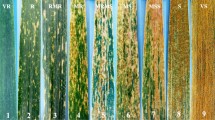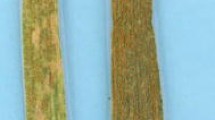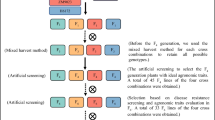Abstract
Several new races of the stripe rust pathogen have become frequent throughout the wheat growing regions of the United States since 2000. These new races are virulent to most of the wheat seedling resistance genes limiting the resistance sources that can be used to combat this pathogen. High-temperature adult-plant (HTAP) stripe rust resistance has proven to be more durable than seedling resistance due to its non-race-specific nature, but its use is limited by the lack of mapping information. We report here the identification of a new HTAP resistance gene from Triticum turgidum ssp. dicoccoides (DIC) designated as Yr36. Lines carrying this gene were susceptible to almost all the stripe rust pathogen races tested at the seedling stage but showed adult-plant resistance to the prevalent races in California when tested at high diurnal temperatures. Isogenic lines for this gene were developed by six backcross generations. Field tests in two locations showed increased levels of field resistance to stripe rust and increased yields in isogenic lines carrying the Yr36 gene compared to those without the gene. Recombinant substitution lines of chromosome 6B from DIC in the isogenic background of durum cv. Langdon were used to map the Yr36 gene on the short arm of chromosome 6B completely linked to Xbarc101, and within a 2-cM interval defined by PCR-based markers Xucw71 and Xbarc136. Flanking locus Xucw71 is also closely linked to the grain protein content locus Gpc-B1 (0.3-cM). Marker-assisted selection strategies are presented to improve stripe rust resistance and simultaneously select for high or low Gpc-B1 alleles.



Similar content being viewed by others
References
1. Avivi L (1978) High protein content in wild tetraploid Triticum dicoccoides Körn. In: Ramanujam S (ed) Proceedings 5th international wheat genet symposium, Indian Soc Genet and Plant Breed, New Delhi, pp 372–380
Bariana HS, Hayden MJ, Ahmed NU, Bell JA, Sharp PJ, McIntosh RA (2001) Mapping of durable adult plant and seedling resistances to stripe rust and stem rust diseases in wheat. Aust J Agr Res 52:1247–1255
Börner A, Röder MS, Unger O, Meinel A (2000) The detection and molecular mapping of a major gene for non-specific adult-plant disease resistance against stripe rust (Puccinia striiformis) in wheat. Theor Appl Genet 100:1095–1099
Cenci A, Chantret N, Xy K, Gu Y, Anderson OD, Fahima T, Distelfeld A, Dubcovsky J (2003) Construction and characterization of a half million clones bacterial artificial chromosome (BAC) library of durum wheat. Theor Appl Genet 107:931–939
Chen XM, Line RF (1992) Inheritance of stripe rust resistance in wheat cultivars used to differentiate races of Puccinia striiformis in North America. Phytopathology 82:633–637
Chen XM, Line RF (1995) Gene action in wheat cultivars for durable, high-temperature, adult-plant resistance and interaction with race-specific, seedling resistance to Puccinia striiformis. Phytopatholohy 85:567–572
7. Chen XM, Milus EA, Long DL, Jackson LF (2004) Impact of wheat stripe rust and races of Puccinia striiformis f. sp. tritici in the United States. In: Proceedings of the 11th international cereal rusts and powdery mildew conference, Norwich, UK. www.crpmb.org/icrpmc11/abstracts.htm
Chen XM, Moore MK (2002) Epidemics and races of Puccinia striiformis in North America in 2001. Phytopathology 92:S14–15
Chen XM, Moore MK, Milus EA, Long DL, Line RF, Marshall D, Jackson L (2002) Wheat stripe rust epidemics and races of Puccinia striiformis f. sp. tritici in the United States in 2000. Plant Dis 86:39–46
Distelfeld A, Uauy C, Olmos S, Schlatter AR, Dubcovsky J, Fahima T (2004) Microcolinearity between a 2-cM region encompassing the grain protein content locus Gpc-6B1 on wheat chromosome 6 and a 350-kb region on rice chromosome 2. Funct Integr Genom 4:59–66
Dubcovsky J, Galvez AF, Dvorak J (1994) Comparison of the genetic organization of the early salt stress response gene system in salt-tolerant Lophopyrum elongatum and salt-sensitive wheat. Theor Appl Genet 87:957–964
Dvorak J, McGuire PE, Cassidy B (1988) Apparent sources of the A genomes of wheats inferred from the polymorphism in abundance and restriction fragment length of repeated nucleotide sequences. Genome 30:680–689
Flor HH (1971) Current status of the gene-for-gene concept. Annu Rev Phytopathol 9:275–296
Gill KS, Gill BS, Endo TR (1993) A chromosome region-specific mapping strategy reveals gene-rich telomeric ends in wheat. Chromosoma 102:374–381
Joppa LR, Du C, Hart GE, Hareland GA (1997) Mapping a QTL for grain protein in tetraploid wheat (Triticum turgidum L.) using a population of recombinant inbred chromosome lines. Crop Sci 37:1586–1589
Khan IA, Procunier JD, Humphreys DG, Tranquilli G, Schlatter AR, Marcucci-Poltri S, Frohberg R, Dubcovsky J (2000) Development of PCR based markers for a high grain protein content gene from Triticum turgidum ssp. dicoccoides transferred to bread wheat. Crop Sci 40:518–524
Large EC (1954) Growth stages in cereals. Illustration of the Feekes scale. Plant Pathol 3:128–129
Line RF, Qayoum A (1992) Virulence, aggressiveness, evolution and distribution of races of Puccinia striiformis (the cause of stripe of wheat) in North America, 1968–1987. USDA Bull 1788:44
Line RF, Chen XM (1995) Successes in breeding for and managing durable resistance to wheat rusts. Plant Dis 79:1254–1255
20. Line RF, Chen XM (1996) Wheat and barley stripe rust in North America. In: Kema GHJ, Niks RE, Daamen RA (eds) Proceedings 9th European and Mediterranean cereal rusts and powdery mildews conference. Lunteren, The Netherlands, pp 101–104
21. Line RF, Chen XM, Gale MD, Leung H (1996) Development of molecular markers associated with quantitative trait loci in wheat for durable resistance to Puccinia striiformis. In: Kema GHJ, Niks RE, Daamen RA (eds) Proceedings 9th European and Mediterranean cereal rusts and powdery mildews conference. Lunteren, The Netherlands, pp 234
22. McIntosh RA, Devos KM, Dubcovsky J, Rogers WJ, Morris CF, Appels R, Anderson OA (2005) Catalogue of gene symbols for wheat: 2005 supplement http://wheat.pw.usda.gov
Michelmore R, Meyers B (1998) Clusters of resistance genes in plants evolve by divergent selection and a birth-and-death process. Genome Res 8:1113–1130
Milus EA, Line RF (1986a) Number of genes controlling high-temperature adult-plant resistance to stripe rust in wheat. Phytopathology 76:93–96
Milus EA, Line RF (1986b) Gene action for inheritance of durable, high-temperature, adult-plant resistance to stripe rust in wheat. Phytopathology 76:435–441
Olmos S, Distelfeld A, Chicaiza O, Schlatter AR, Fahima T, Echenique V, Dubcovsky J (2003) Precise mapping of a locus affecting grain protein content in durum wheat. Theor Appl Genet 107:1243–1251
Qayoum A, Line RF (1985) High-temperature, adult-plant resistance to stripe rust of wheat. Phytopathology 75:1121–1125
Ramburan VP, Pretorius ZA, Louw JH, Boyd LA, Smith PH, Boshoff WH, Prins R (2004) A genetic analysis of adult plant resistance to stripe rust in the wheat cultivar Kariega. Theor Appl Genet 108:1426–1433
Röder MS, Korzun V, Wendehake K, Plaschke J, Tixier MH, Leroy P, Ganal MW (1998) A microsatellite map of wheat. Genetics 149:2007–2023
Singh RP, Nelson JC, Sorrells ME (2000) Mapping of Yr28 and other genes for resistance to stripe rust in wheat. Crop Sci 40:1148–1155
31. SAS Institute Inc (2003) SAS user’s guide, Version 8.2. SAS Institute, Inc., Cary, NC
Suenaga K, Singh RP, Huerta-Espino J, William HM (2003) Microsatellite markers for genes Lr34/Yr18 and other quantitative trait loci for leaf rust and stripe rust resistance in bread wheat. Phytopathology 93:881–890
Young ND, Tanksley S (1989) Restriction fragment length polymorphism maps and the concept of graphical genotypes. Theor Appl Genet 77:95–101
Acknowledgements
The project was supported by the National Research Initiative of the USDA Cooperative State Research, Education and Extension Service, grant number 2005-00975, USDA-IFAFS grant 2001-04462 and Research Grant Award No. US-3573-04C from BARD, The United States - Israel Binational Agricultural Research and Development Fund. The authors thank Drs. Kim Kidwell and Dipak Santra (Washington State University) for sharing unpublished mapping information.
Author information
Authors and Affiliations
Corresponding author
Additional information
Communicated by Beat Keller
Rights and permissions
About this article
Cite this article
Uauy, C., Brevis, J.C., Chen, X. et al. High-temperature adult-plant (HTAP) stripe rust resistance gene Yr36 from Triticum turgidum ssp. dicoccoides is closely linked to the grain protein content locus Gpc-B1 . Theor Appl Genet 112, 97–105 (2005). https://doi.org/10.1007/s00122-005-0109-x
Received:
Accepted:
Published:
Issue Date:
DOI: https://doi.org/10.1007/s00122-005-0109-x




